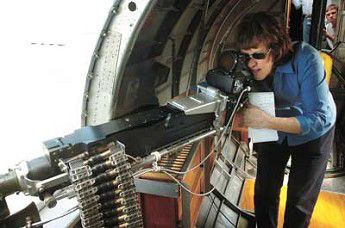Reporter takes sentimental journey for the first time
Published 2:50 am Tuesday, August 4, 2009

- Senior reporter Kathy Aney looks at the countryside through a machine gun scope during her recent ride on a B-12 bomber.<br><I>Staff photo by E.J. Harris
Walter Cronkite, the legendary news anchor who died last week, covered World War II. He embedded with troops before “embedding” was cool. He parachuted with the 101st Airborne.
In 1943, Cronkite flew B-17 bombing raids, wearing a uniform and spraying the sky with machine gun fire.
As a Cronkite fan, he was on my mind recently as I boarded one of the few B-17s still flying. Sentimental Journey, based at Falcon Field in Mesa, Ariz., stopped in Walla Walla for a few days and opened to the public and made several flights.
Before my flight, I settled into a seat in the radio room, letting my imagination drift. In my mind’s eye, I was Cronkite getting ready to fly a WWII bombing raid over Germany with nine or 10 really brave young men. Old black-and-white photos of pilots, gunners and bombardiers in flight jackets, helmets and goggles jumped to life, colorizing in my mind’s eye as they moved confidently to their stations in the confined space, all bravado and bluster.
The ball turret gunner, possibly the gutsiest of them all, headed to the ball turret on the belly of the plane. In a hunched position, he could shoot at enemy attackers in a 360-degree radius. So confined was the revolving sphere that the gunner couldn’t wear his parachute. He could only put his arm through one shoulder strap on and hurriedly don the other if a jump was necessary.
The crew’s two waist gunners took their places on opposite sides of the plane where machine guns were mounted on window frames. The tail gunner went aft as the pilot, copilot, flight engineer, navigator and radio operator took spots up front. The bombardier settled in the B-17’s plexiglass nose, ready to drop the flying fortress’s payload of bombs.
Suddenly, I peeled away from my fantasy as the B-17’s four engines sputtered and coughed to life, increasing to a roar as the plane gained speed on the runway. I pulled out my iPhone and fingered the icon for my newest application – a decibel meter. The needle rose to an average of 100 decibels, not as loud as a rock concert or a jet, but rivaling a motorcycle or lawnmower.
One of the flight crew members motioned us to unbelt and walk around inside the plane. I hopped out of my seat and inspected the plane’s shell, simple and unadorned, dotted by thousands of rivets. I looked through one of the waist gunner’s machine guns, sighting on a barn, then a wheat field.
The pilot opened the bomb bay door so we could look straight down at the earth below. I imagine a half dozen bombs falling towards an airfield, oil refinery, engine factory or other strategic target. In my mind’s eye, the sky blackened with German jet fighters, fireballs lighting up the sky. For my imaginary gunners, adrenaline flowed like a Class VI rapids.
A member of the flight crew, the real one, beckoned me to the cockpit. The instrument panel is a mishmash of old and new – low-tech gear and flap indicators, fuel gauge, compass, tachometer and dozens of old-style indicators intermixed with FAA-compliant instruments that B-17 pilots never saw.
As we landed, wheels touch down smoothly and I felt some small measure of a WWII flight crew’s relief at getting their flying fortress to safety after a successful mission.
On the ground, I listened as an 88-year-old former B-17 pilot relived his experiences. Never once, he said, did his plane come back unscathed. One time, he recalled, they counted 232 holes.
Cronkite once quoted a B-17 crew member as saying, “The shelling was so thick, you could get out and walk on it” and later added, “I’ve just returned from an assignment to hell, a hell at 17,000 feet, a hell of bursting flak and screaming fighter planes.”
As with Cronkite, our WWII veterans are slipping away. Standing on the tarmac, I gave the B-17 one last look, overwhelmed with their sacrifice and bravery.






